Click on images to enlarge

infestation (Photo: Trevor James)

climbing habit (Photo: Sheldon Navie)
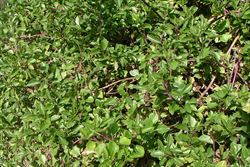
scrambling habit (Photo: Sheldon Navie)
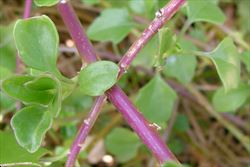
close-up of slightly fleshy reddish-coloured stems (Photo: Sheldon Navie)
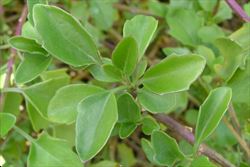
slightly fleshy leaves (Photo: Sheldon Navie)
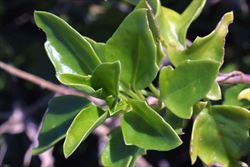
close-up of leaves with irregularly toothed margins (Photo: Trevor James)

cluster of young flower-heads (Photo: Trevor James)
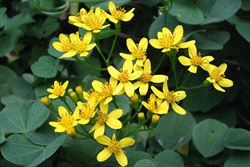
cluster of flower-heads (Photo: Sheldon Navie)

close-up of flower-head from side-on (Photo: Greg Jordan)

immature seed-heads (Photo: Sheldon Navie)
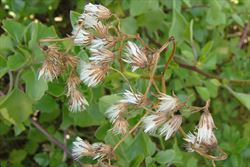
mature seed-heads with fluffy seeds (Photo: Sheldon Navie)
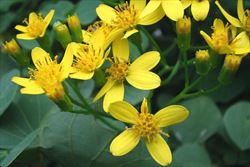
flower-heads with yellow 'petals' (Photo: Sheldon Navie)
Scientific Name
Senecio angulatus L. f.
Synonyms
Senecio tamoides DC. (misapplied)
Family
Asteraceae (Queensland, New South Wales, the ACT, Victoria, Tasmania, Western Australia and the Northern Territory)Compositae (South Australia)
Common Names
Cape ivy, climbing groundsel, creeping groundsel, garden senecio, mile-a-minute, scrambling groundsel
Origin
Native to southern Africa (i.e. Cape Province in South Africa).
Cultivation
An introduced garden plant (i.e. ornamental) that is most commonly cultivated in temperate regions.
Naturalised Distribution
Widely naturalised, particularly in the coastal districts of southern Australia. It is relatively common in the coastal districts of southern and central New South Wales, in southern Victoria and in south-eastern South Australia. Also occasionally naturalised in the coastal districts of south-western Western Australia, and sparingly naturalised in Tasmania and south-eastern Queensland.
Also naturalised overseas in New Zealand.
Habitat
A weed of open woodlands, urban bushland, disturbed sites, coastal environs, waste areas, gardens and roadsides.
Habit
A long-lived (i.e. perennial) scrambling or climbing plant growing up to 5 m tall.
Distinguishing Features
- a long-lived scrambling or climbing plant growing up to 5 m tall.
- its alternately arranged leaves (3-5 cm long) are hairless and slightly fleshy in nature.
- these leaves are egg-shaped in outline or somewhat diamond-shaped with shallowly lobed or toothed margins.
- its daisy-like flower-heads are arranged in loose clusters at the tips of the branches.
- each of these yellow flower-heads has several tiny tubular flowers surrounded by 4-6 'petals' (6-9 mm long).
- its pale brown 'seeds' (2-2.5 mm long) are topped with a ring of long white hairs (6-7 mm long).
Stems and Leaves
The slightly fleshy stems are hairless (i.e. glabrous).
The alternately arranged leaves are egg-shaped in outline (i.e. ovate) or somewhat diamond-shaped (i.e. rhombic). These leaves (3-5 cm long and 1-5 cm) are hairless (i.e. glabrous) and slightly fleshy (i.e. succulent). Their margins are usually shallowly lobed or toothed (i.e. serrate), rarely entire, with pointed tips (i.e. acute apices).
Flowers and Fruit
The daisy-like flower-heads (i.e. capitula) are arranged in loose clusters (4-8 cm across) at the tips of the branches (i.e. in terminal corymbose panicles). These flower-heads have 4-6 yellow 'petals' (i.e. ray florets) 6-9 mm long and are surrounded by several (7-9) small green bracts (5-7 mm long). There are also several (10-15) tiny tubular yellow flowers (i.e. tubular or disc florets) in the centre of each flower-head. Flowering occurs mainly during late autumn and winter (i.e. from May to July).
The 'seeds' (i.e. achenes or cypselas) are pale brown in colour and covered in a few tiny scattered hairs. These 'seeds' (2-2.5 mm long) are also topped with a ring (i.e. pappus) of long white hairs (6-7 mm long) that readily become detached.
Reproduction and Dispersal
This species reproduces by seed and also via stem segments. Its seed are dispersed by wind and animals, while its seeds and stem segments can also be spread in dumped garden waste.
Environmental Impact
Climbing groundsel (Senecio angulatus) is a significant environmental weed in Victoria and a minor or emerging environmental weed in South Australia, Tasmania, New South Wales and Western Australia.
Legislation
Not declared or considered noxious by any state government authorities.
Similar Species
Climbing groundsel (Senecio angulatus) is very similar to Cape ivy (Delairea odorata), canary creeper (Senecio tamoides) and Natal ivy (Senecio macroglossus). These species can be distinguished by the following differences:
- climbing groundsel (Senecio angulatus) has moderately large bright yellow flower-heads (i.e. capitula) with several 'petals' (i.e. ray florets) 6-9 mm long.
- Cape ivy (Delairea odorata) has small bright yellow flower-heads (i.e. capitula) with no obvious 'petals' (i.e. ray florets).
- canary creeper (Senecio tamoides) has moderately large bright yellow flower-heads (i.e. capitula) with several 'petals' (i.e. ray florets) about 10 mm long.
- Natal ivy (Senecio macroglossus) has relatively large pale yellow flower-heads (i.e. capitula) with several prominent 'petals' (i.e. ray florets) more than 2 cm long.

